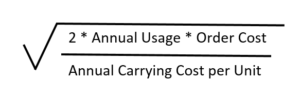One of the first questions I heard asked when I started working with Epicor’s P21 ERP system was “What is Prophet 21’s EOQ Replenishment used for?”. I was horrified at the answer I heard. The response was a lot of double talk from a consultant that really should have just said “I don’t know.” Instead, 200 people walked out of the room with a lot of confusion on the subject.
EQO stands for “Economic Order Quantity”. Simply stated, this is the order quantity that minimizes the total cost of ownership. The formula to calculate the EOQ takes into account the cost of ordering as well as the cost of carrying inventory. It is a fairly complex math equation, but it has been around for over 100 years and is one of the more common methods of calculating how much to buy.
How EOQ Works
First, let’s take a look at the traditional EOQ formula and then break it down into it’s parts:
- Annual Usage: This is the number of units sold in a year
- Order Cost: This is the cost of issuing a purchase order
- Annual Carrying Cost Per Unit: This is the replacement cost times the carrying cost percentage
It is critical that each of these numbers be correct, otherwise the EOQ calculation will be worthless to you. Calculating the carrying cost and the reordering cost are not simple tasks. These things need the time for a careful study of the costs in order to get your EOQ calculation dialed in. I highly recommend effectiveinventory.com as a resource for making these calculations. Jon Schreibfeder has built what I believe to be the most complete and accurate models for carrying cost and replenishment cost. If you use this and fill them out properly, you are likely to get a solid EOQ calculation.
Fortunately, Prophet 21 makes this calculation for you. You will see it on the purchase stock card in the Order Quantity section for any EOQ item. A sample of this screen is shown below.
As you can see, P21 is applying the math in line with the EOQ formula above. No real surprises here.
What is Prophet 21’s System Setting that Needs to be Checked?
Like everything in Prophet 21, for EOQ to work, it has to be set up correctly. The 2 settings that you will want to pay the most attention to are the Ordering Cost and Carrying Cost. Fortunately both of these settings are located in the Company Purchasing Maintenance Screen:
The Cost to Order should be entered in dollars and cents (e.g. 5.50). For the carrying cost, enter a decimal value that corresponds to the percentage of your carrying cost. For example, 23% would be entered as .23. Prophet 21 will calculate the usage forecast using the same formulas and method as Up To. The replacement cost will be based on the supplier cost that you have defined. Once you have all of these settings accurately set, you can change the item to EOQ. This is done in item maintenance on the replenishment tab for the appropriate location.
When Should I Use EOQ?
Once you have asked the big question (What is Prophet 21’s EOQ Feature?), the next question is even bigger. When should I use it? This is not a decision you should be making in a vacuum. Using EOQ has real implications on the inventory investment, since it will tend to order more than a normal Up To calculation. For many years, EOQ was the method of choice when the only consideration was to maximize profitability. The offset to this is that you will carry more inventory when EOQ triggers and this will impact your company’s cash flow and warehouse storage space.
Cash management is a much more prevalent issue now than it used to be. More and more, companies are focused on managing cash, even to the point that they will give up some profit to do it. This is especially true in the private equity markets where very often, the equity stakeholders and boards lean on management to run the business for cash flow. If cash management is not a huge concern, then EOQ will tend to push you toward the lowest total cost of ownership.
I personally tend to use EOQ sparingly. I do find it to be useful on items with a very low unit cost. Buying 100 of a part that costs less than a cent every week doesn’t make any sense. This has typically proven to be a good use case for EOQ, even if you are running the business for cash flow.
What is Prophet 21 EOQ – The Short Version
EOQ has been around for over 100 years. It’s designed to buy based on the lowest total cost. This may be a good fit for you if that’s how you want to manage your inventory. However, EOQ is probably not a good fit if your business is focused on managing for maximum cash flow. I do believe that there is an exception for very low value items. Those might make sense to buy as EOQ anyway. The other consideration is space. If you are very tight on warehouse space, EOQ may not be the best choice.
Hopefully this clears up the EOQ mystery for you.
For other answers to questions that start with “What is Prophet 21 …” click here.










